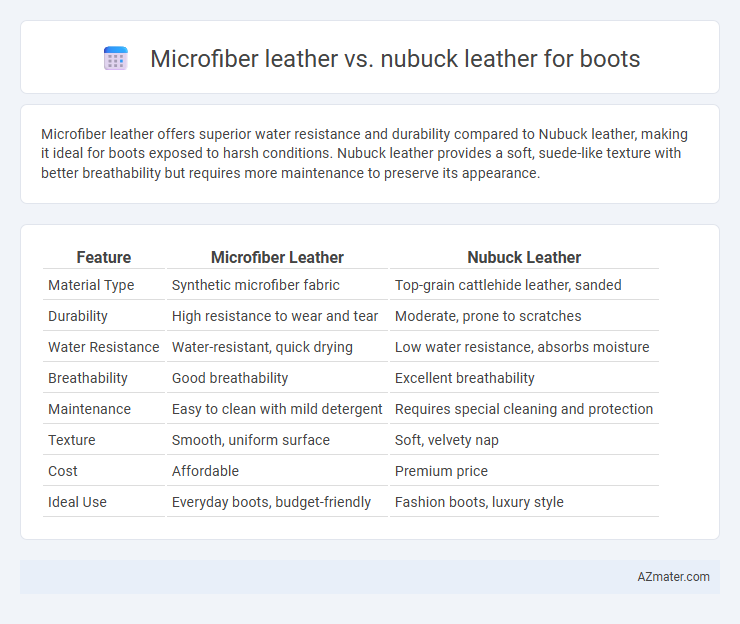Microfiber leather offers superior water resistance and durability compared to Nubuck leather, making it ideal for boots exposed to harsh conditions. Nubuck leather provides a soft, suede-like texture with better breathability but requires more maintenance to preserve its appearance.
Table of Comparison
| Feature | Microfiber Leather | Nubuck Leather |
|---|---|---|
| Material Type | Synthetic microfiber fabric | Top-grain cattlehide leather, sanded |
| Durability | High resistance to wear and tear | Moderate, prone to scratches |
| Water Resistance | Water-resistant, quick drying | Low water resistance, absorbs moisture |
| Breathability | Good breathability | Excellent breathability |
| Maintenance | Easy to clean with mild detergent | Requires special cleaning and protection |
| Texture | Smooth, uniform surface | Soft, velvety nap |
| Cost | Affordable | Premium price |
| Ideal Use | Everyday boots, budget-friendly | Fashion boots, luxury style |
Introduction: Microfiber Leather vs Nubuck Leather for Boots
Microfiber leather offers durability, water resistance, and easy maintenance, making it ideal for everyday boots exposed to various weather conditions. Nubuck leather, crafted from top-grain cattle hide sanded on the grain side, provides a soft, velvety texture and excellent breathability but requires more careful upkeep to maintain its appearance. Choosing between microfiber and nubuck leather for boots depends on balancing durability and maintenance needs with aesthetic preference and comfort.
Material Composition and Production Processes
Microfiber leather features a synthetic composition primarily made of polyester and polyurethane, engineered through a hot-pressing process to mimic natural leather's grain and texture. Nubuck leather is crafted from top-grain cattle hide that undergoes sanding or buffing on the grain side to create its characteristic velvety surface, preserving the hide's natural breathability. Production of microfiber leather involves precision layering and embossing for durability and water resistance, whereas Nubuck requires careful natural hide selection and post-tanning treatments to maintain suppleness and aesthetic appeal.
Durability and Longevity Comparison
Microfiber leather offers superior water resistance and scratch durability compared to Nubuck leather, making it ideal for boots exposed to harsh conditions. Nubuck leather requires regular maintenance and conditioning to retain its texture and prevent premature wear, while microfiber leather maintains its appearance with minimal care. The synthetic fibers in microfiber leather contribute to longer lifespan and consistent durability, whereas Nubuck's natural grain can be vulnerable to abrasion and environmental damage over time.
Comfort and Breathability Factors
Microfiber leather offers enhanced breathability and moisture-wicking properties due to its synthetic fiber construction, making it ideal for long-term comfort in boots. Nubuck leather, derived from top-grain cattle hide, provides natural breathability and a soft, velvety texture that molds to the foot over time for personalized comfort. While microfiber leather excels in consistent ventilation and water resistance, nubuck leather stands out for its natural ability to allow air circulation, reducing sweat buildup and enhancing overall foot comfort.
Waterproofing and Weather Resistance
Microfiber leather offers superior waterproofing due to its synthetic composition, making it highly resistant to moisture and ideal for wet conditions. Nubuck leather, while breathable and durable, requires regular treatment with water repellents to maintain weather resistance and prevent water damage. For boots exposed to heavy rain or snow, microfiber leather provides more consistent protection against moisture and harsh weather elements.
Aesthetic Appeal and Texture Differences
Microfiber leather offers a smooth, uniform surface with a sleek and polished aesthetic, ideal for a modern and clean boot design. Nubuck leather, characterized by its velvety, suede-like texture with a natural matte finish, provides a rich and rugged look that enhances character over time. The contrasting textures highlight the choice between microfiber's durability and ease of maintenance versus nubuck's luxurious feel and unique aging properties.
Maintenance and Cleaning Requirements
Microfiber leather offers a low-maintenance advantage as it resists stains and can be easily cleaned with a damp cloth, making it highly durable for boots exposed to daily wear. Nubuck leather requires more careful upkeep, needing regular brushing with a soft bristle brush to maintain its distinctive texture and occasional application of specialized leather cleaners and conditioners to prevent drying and cracking. Both materials demand different care routines, with microfiber leather favored for easy cleaning and Nubuck leather for preserving natural aesthetics.
Sustainability and Environmental Impact
Microfiber leather offers a more sustainable alternative to traditional nubuck leather by utilizing synthetic fibers that reduce the demand for animal hides and minimize water consumption during production. Nubuck leather, derived from natural animal hides, involves more intensive resource use, including significant water, energy, and chemical treatments that contribute to higher environmental impact. Choosing microfiber leather for boots supports eco-friendly manufacturing processes, lessens deforestation, and aligns with growing consumer demand for cruelty-free and low-impact materials.
Price and Value Analysis
Microfiber leather offers a cost-effective alternative to Nubuck leather, often priced 30-50% lower while maintaining durability and water resistance, making it ideal for budget-conscious consumers seeking value without sacrificing performance. Nubuck leather commands a premium price due to its natural breathability, supple texture, and aging characteristics, appealing to buyers prioritizing luxury and long-term investment in their boots. When evaluating boots, microfiber leather maximizes affordability and low maintenance, whereas Nubuck leather provides enhanced comfort and a sophisticated aesthetic at a higher initial cost.
Best Uses and Recommendations for Boots
Microfiber leather offers superior water resistance and durability, making it ideal for everyday work boots and outdoor activities where exposure to moisture and dirt is common. Nubuck leather provides a soft, breathable, and stylish finish, best suited for casual or fashion boots where comfort and appearance are prioritized over rugged use. For hiking or heavy-duty boots, microfiber leather is recommended, while nubuck leather excels in urban and light-use environments.

Infographic: Microfiber leather vs Nubuck leather for Boot
 azmater.com
azmater.com